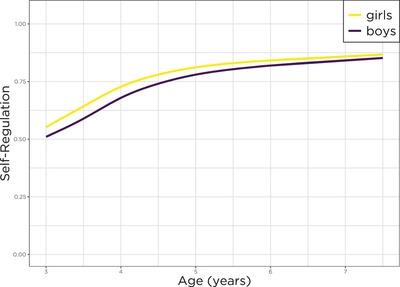Our official English website, www.x-mol.net, welcomes your feedback! (Note: you will need to create a separate account there.)
Studying children's growth in self-regulation using changing measures to account for heterotypic continuity: A Bayesian approach to developmental scaling
Developmental Science ( IF 4.939 ) Pub Date : 2022-05-26 , DOI: 10.1111/desc.13280 Alexis Hosch 1 , Jacob J Oleson 2 , Jordan L Harris 1 , Mary Taylor Goeltz 3 , Tabea Neumann 4 , Brandon LeBeau 5 , Eliot Hazeltine 1 , Isaac T Petersen 1
Developmental Science ( IF 4.939 ) Pub Date : 2022-05-26 , DOI: 10.1111/desc.13280 Alexis Hosch 1 , Jacob J Oleson 2 , Jordan L Harris 1 , Mary Taylor Goeltz 3 , Tabea Neumann 4 , Brandon LeBeau 5 , Eliot Hazeltine 1 , Isaac T Petersen 1
Affiliation

|
Self-regulation is thought to show heterotypic continuity–its individual differences endure but its behavioral manifestations change across development. Thus, different measures across time may be necessary to account for heterotypic continuity of self-regulation. This longitudinal study examined children's (N = 108) self-regulation development using 17 measures, including 15 performance-based measures, two questionnaires, and three raters across seven time points. It is the first to use different measures of self-regulation over time to account for heterotypic continuity while using developmental scaling to link the measures onto the same scale for more accurate growth estimates. Assessed facets included inhibitory control, delayed gratification, sustained attention, and executive functions. Some measures differed across ages to retain construct validity and account for heterotypic continuity. A Bayesian longitudinal mixed model for developmental scaling was developed to link the differing measures onto the same scale. This allowed charting children's self-regulation growth across ages 3–7 years and relating it to both predictors and outcomes. Rapid growth occurred from ages 3–6. As a validation of the developmental scaling approach, greater self-regulation was associated with better school readiness (math and reading skills) and fewer externalizing problems. Our multi-wave, multi-facet, multi-method, multi-measure, multi-rater, developmental scaling approach is the most comprehensive to date for assessing the development of self-regulation. This approach demonstrates that developmental scaling may enable studying development of self-regulation across the lifespan.
中文翻译:

使用变化的措施来解释异型连续性来研究儿童在自我调节方面的成长:一种发展尺度的贝叶斯方法
自我调节被认为表现出异型连续性——其个体差异持续存在,但其行为表现在整个发展过程中发生变化。因此,可能需要跨时间采取不同的措施来解释自我调节的异型连续性。这项纵向研究检查了儿童的 ( N= 108) 使用 17 项措施进行自我调节发展,包括 15 项基于绩效的措施、两份问卷和跨越七个时间点的三名评估者。这是第一个随着时间的推移使用不同的自我调节措施来解释异型连续性,同时使用发展尺度将措施链接到相同的尺度以获得更准确的增长估计。评估的方面包括抑制控制、延迟满足、持续注意力和执行功能。一些措施因年龄而异,以保持结构有效性并解释异型连续性。开发了用于发展尺度的贝叶斯纵向混合模型,以将不同的措施联系到同一尺度上。这允许绘制 3-7 岁儿童的自我调节成长图表,并将其与预测因素和结果联系起来。快速增长发生在 3-6 岁。作为发展规模方法的验证,更强的自我调节与更好的入学准备(数学和阅读技能)和更少的外化问题相关。我们的多波、多方面、多方法、多测量、多评估者、发展尺度方法是迄今为止评估自我调节发展的最全面方法。这种方法表明,发展规模可能有助于研究整个生命周期中自我调节的发展。发展规模法是迄今为止最全面的评估自我调节发展的方法。这种方法表明,发展规模可能有助于研究整个生命周期中自我调节的发展。发展规模法是迄今为止最全面的评估自我调节发展的方法。这种方法表明,发展规模可能有助于研究整个生命周期中自我调节的发展。
更新日期:2022-05-26
中文翻译:

使用变化的措施来解释异型连续性来研究儿童在自我调节方面的成长:一种发展尺度的贝叶斯方法
自我调节被认为表现出异型连续性——其个体差异持续存在,但其行为表现在整个发展过程中发生变化。因此,可能需要跨时间采取不同的措施来解释自我调节的异型连续性。这项纵向研究检查了儿童的 ( N= 108) 使用 17 项措施进行自我调节发展,包括 15 项基于绩效的措施、两份问卷和跨越七个时间点的三名评估者。这是第一个随着时间的推移使用不同的自我调节措施来解释异型连续性,同时使用发展尺度将措施链接到相同的尺度以获得更准确的增长估计。评估的方面包括抑制控制、延迟满足、持续注意力和执行功能。一些措施因年龄而异,以保持结构有效性并解释异型连续性。开发了用于发展尺度的贝叶斯纵向混合模型,以将不同的措施联系到同一尺度上。这允许绘制 3-7 岁儿童的自我调节成长图表,并将其与预测因素和结果联系起来。快速增长发生在 3-6 岁。作为发展规模方法的验证,更强的自我调节与更好的入学准备(数学和阅读技能)和更少的外化问题相关。我们的多波、多方面、多方法、多测量、多评估者、发展尺度方法是迄今为止评估自我调节发展的最全面方法。这种方法表明,发展规模可能有助于研究整个生命周期中自我调节的发展。发展规模法是迄今为止最全面的评估自我调节发展的方法。这种方法表明,发展规模可能有助于研究整个生命周期中自我调节的发展。发展规模法是迄今为止最全面的评估自我调节发展的方法。这种方法表明,发展规模可能有助于研究整个生命周期中自我调节的发展。



























 京公网安备 11010802027423号
京公网安备 11010802027423号